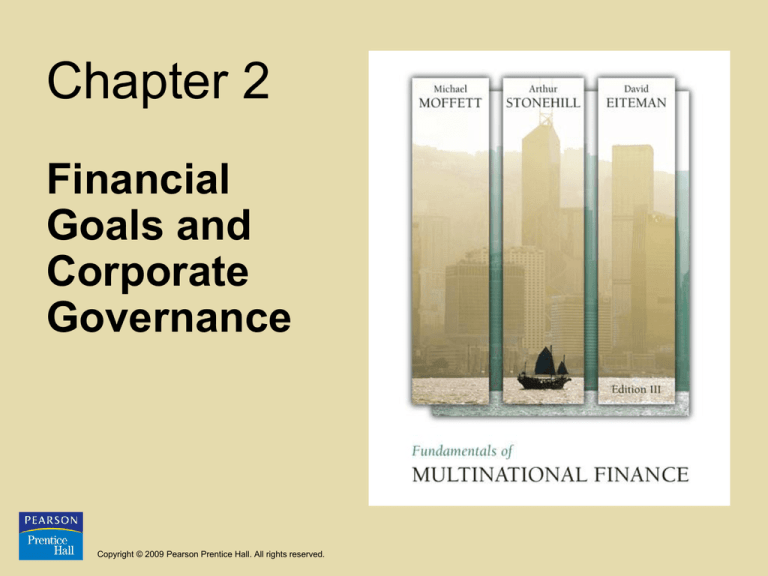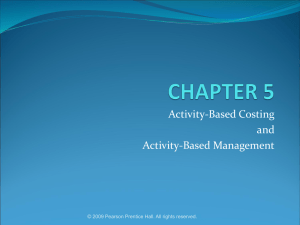
Chapter 2
Financial
Goals and
Corporate
Governance
Copyright © 2009 Pearson Prentice Hall. All rights reserved.
The Globalization Process:
Learning Objectives
• Examine how businesses can be owned, and how this
impacts the separation between ownership and
management – the agency problem
• Evaluate the distinctions between the two major forms
of management goals – stockholder wealth
maximization versus stakeholder capitalism
Copyright © 2009 Pearson Prentice Hall. All rights reserved.
2-2
The Globalization Process:
Learning Objectives
• Distinguish between the actual operational goals
which maybe pursued by management
depending on whether the company is operated
by owners or professional management
• Study the goals and forms of corporate
governance in use in the global marketplace
today
• Learn from failures in corporate governance
Copyright © 2009 Pearson Prentice Hall. All rights reserved.
2-3
Basic Questions
• Who owns the business?
• Do the owners manage the business themselves?
• Most companies start as 100% family owned and move
toward being 100% publicly traded
• Sometimes publicly traded firms return to being
privately held
• Family controlled firms often out-perform publicly
traded firms
• Moving from family to public firms brings agency
issues
Copyright © 2009 Pearson Prentice Hall. All rights reserved.
2-4
Exhibit 2.1 Who Owns the
Business?
Copyright © 2009 Pearson Prentice Hall. All rights reserved.
2-5
What is the Goal of Management?
• As Trident becomes more deeply committed to
multinational operations, a new constraint develops –
one that springs from divergent worldwide opinions and
practices as to just what the firms’ overall goal should
be:
– Shareholder Wealth Maximization – As characterized by
Anglo-American markets
– Stakeholder Capitalism Model – As characterized by
Continental European and Japanese markets
Copyright © 2009 Pearson Prentice Hall. All rights reserved.
2-6
The Goal of Management
• Shareholder Wealth Maximization
– A firm should strive to maximize the return to shareholders
(those individuals owning equity shares in the firm)
– This view defines risk in a very strict financial sense
– Risk is defined as the added risk a firm’s shares bring to a
diversified portfolio (a fully diversified portfolio represents
systematic risk)
– The added firm-specific risk is known as unsystematic risk
Copyright © 2009 Pearson Prentice Hall. All rights reserved.
2-7
Shareholder Wealth Maximization
• Agency Theory – the study of how shareholders (SH)
can motivate management to act in SH best interests
• Long-term versus short-term value maximization
– Impatient capitalism focuses on the short-term sometimes at
the expense of long-term value
– Exacerbated by improper management incentives from SH
Copyright © 2009 Pearson Prentice Hall. All rights reserved.
2-8
Stakeholder Capitalism Model
• A view that all a corporations stakeholders (employees,
management, suppliers, local community, local/national
government and creditors) need to be considered in addition to
the equity holders
• The goal is to earn as much as possible in the long run, but to
retain enough to increase the corporate wealth for the benefit of
all
• The definition of corporate wealth is much broader than just
financial wealth, it includes technical, market and human
resources as well
• Doesn’t make an issue of market efficiency because long-term
loyal SH should be more influential than transient SH
Copyright © 2009 Pearson Prentice Hall. All rights reserved.
2-9
Stakeholder Capitalism Model
• Risk – Total risk, both operating and financial
risk, is important
• Single versus Multiple Goals – Avoids the
problem of impatient capital but fails to give
clear expectations about tradeoffs among
different groups of stakeholders
• The Score Card – Firms worldwide are moving
more toward the SWM model
Copyright © 2009 Pearson Prentice Hall. All rights reserved.
2-10
Operational Goals
• Return to stockholder:
– Dividend yield + Capital Gains
• A privately held firm has a much simpler
shareholder return function: maximize current
and sustainable income.
• Privately held firm may also be less aggressive
and take fewer risks
Copyright © 2009 Pearson Prentice Hall. All rights reserved.
2-11
Operational Goals for MNEs
• Must determine the proper balance between
three operational financial objectives:
• Maximization of consolidated after-tax income
• Minimization of the firm’s effective global tax
burden
• Correct positioning of the firm’s income, cash
flows and available funds as to country and
currency
Copyright © 2009 Pearson Prentice Hall. All rights reserved.
2-12
Corporate Governance
• The relationship among stakeholders used to determine
and control the strategic direction and performance of
an organization is termed corporate governance
• The corporate governance of the organization is
therefore the way in which order and process is
established to ensure that decisions are made and
interests are represented – for all stakeholders properly
Copyright © 2009 Pearson Prentice Hall. All rights reserved.
2-13
Corporate Governance
• The single overriding objective of corporate
governance in the shareholder wealth model is the
optimization over time of the returns to shareholders
• The most widely accepted statement of good corporate
governance (established by the OECD) focus on the
following principles;
–
–
–
–
The rights and equitable treatment of shareholders
The role of stakeholders in corporate governance
Disclosure and transparency
The responsibilities of the board
Copyright © 2009 Pearson Prentice Hall. All rights reserved.
2-14
Exhibit 2.2 The Structure of
Corporate Governance
Copyright © 2009 Pearson Prentice Hall. All rights reserved.
2-15
The Structure of Corporate Governance
• The Board of Directors
– The legal body accountable for the governance of the
corporation
• Officers and Management
– Creators and directors of the firm’s strategic and operational
direction
• Equity Markets
– Reflect the market’s constant evaluation of the promise and
performance of the company
Copyright © 2009 Pearson Prentice Hall. All rights reserved.
2-16
The Structure of Corporate Governance
• Debt Markets
– Provide funding and are interested in the financial health of
the firm
• Auditors and Legal Advisors
– Provide an external professional opinion as to the fairness,
legality, and accuracy of financial statements
• Regulators
– Require a regular and orderly disclosure process of corporate
performance
Copyright © 2009 Pearson Prentice Hall. All rights reserved.
2-17
Corporate Governance
• The origins of the need for a corporate governance
process arise from the separation of ownership from
management, and from the varying views by culture of
who the stakeholders are and of what significance
• A governance regime (system) is a function of;
– Financial market development
– The degree of separation between management and
ownership
– The concept of disclosure and transparency
Copyright © 2009 Pearson Prentice Hall. All rights reserved.
2-18
Corporate Governance
• Market-based regimes (U.S. and U.K.) are
characterized by relatively efficient capital markets
with dispersed ownership
• Family-based regimes (Asia, Latin America) involve
strong concentrations of family ownership
• Bank-based and government-based regimes result in
only marginal public ownership and sometimes
significant restrictions on business practices
Copyright © 2009 Pearson Prentice Hall. All rights reserved.
2-19
Exhibit 2.3 Comparative Corporate
Governance Regimes
Copyright © 2009 Pearson Prentice Hall. All rights reserved.
2-20
Corporate Governance
• Does good governance matter?
• Certainly, as in the case of Enron, many of the
improprieties were overlooked as long as the company’s
share price continued to rise
• However, after the fall of Enron, and the substantial losses
sustained by investors, employees and society as a whole,
many would say that corporate governance
matters a lot
• Good governance is measured on the basis of accounting
standards, the perceived legal standards in a country, and
the number of Anglo-American board members
Copyright © 2009 Pearson Prentice Hall. All rights reserved.
2-21
Exhibit 2.4 The Value of Good
Governance
Copyright © 2009 Pearson Prentice Hall. All rights reserved.
2-22
Exhibit 2.5 The Premium Paid for
Voting Shares: Accounting Standards
Copyright © 2009 Pearson Prentice Hall. All rights reserved.
2-23
Exhibit 2.6 The Premium Paid for
Voting Shares: Law Enforcement
Copyright © 2009 Pearson Prentice Hall. All rights reserved.
2-24
Corporate Governance Reform
•
Sarbanes Oxley (SOX) has four major requirements:
1. Signature Clause – CEOs and CFOs must vouch for
accuracy of the published financial statements
2. Firm audit and compensation committees must be
comprised of independent/outside directors
3. Loans by the firm to corporate officers and directors are
prohibited
4. Internal controls must be tested for protection against
financial fraud
Copyright © 2009 Pearson Prentice Hall. All rights reserved.
2-25
Corporate Governance Reform
• Board Structure and Compensation
– Some suggest that U.S. corporate boards should be more like
European boards
– Research suggests that compensation for board members is
not a significant problem
• Transparency, Accounting and Auditing
– U.S accounting practices are rule-based and can be abused by
smart accountants
– European accounting practices are conceptually-based
• Minority Shareholder Rights are still as issue
Copyright © 2009 Pearson Prentice Hall. All rights reserved.
2-26
Exhibit 2.7 Board Composition and
Compensation, Fortune 100
Copyright © 2009 Pearson Prentice Hall. All rights reserved.
2-27
Exhibit 2.8 Potential Responses to
Shareholder Dissatisfaction
Copyright © 2009 Pearson Prentice Hall. All rights reserved.
2-28
Summary of Learning Objectives
• Most companies are created by entrepreneurs
• Over time some firms choose to go public
• The US and UK stock markets are characterized by widespread
ownership of shares. In the rest of the world, ownership is
usually characterized by controlling shareholders. Typical
controlling shareholders are government, institutions, family, and
consortiums
• Publicly held firms are typically run by professional managers
whose interests may not be perfectly aligned with owners thus
creating an agency problem
Copyright © 2009 Pearson Prentice Hall. All rights reserved.
2-29
Summary of Learning Objectives
• In the Anglo-American markets the firm’s objective is
to maximize shareholder’s wealth
• In the non-Anglo-American (i.e., stakeholder
capitalism model) markets shareholders are more
constrained by other stakeholders, primarily labor
unions, government, and banks
Copyright © 2009 Pearson Prentice Hall. All rights reserved.
2-30
Summary of Learning Objectives
• Returns to shareholders in publicly traded firms
combine current income and capital gains
• Privately held firms try to maximize current and
sustainable income and waste no resources on
influencing the market’s opinion
• The MNE must balance among maximizing
consolidated after tax income, minimizing global
taxation, and positioning of income, cash flow and
currency
Copyright © 2009 Pearson Prentice Hall. All rights reserved.
2-31
Summary of Learning Objectives
• The MNE must determine for itself the proper
balance between three common operational
objectives:
– Maximization of consolidated after-tax income
– Minimization of the firm’s effective global tax
burden
– Correct positioning of the firm’s income, cash flows,
and available funds as to country and currency
Copyright © 2009 Pearson Prentice Hall. All rights reserved.
2-32
Summary of Learning Objectives
• The relationship among stakeholders used to determine
and control the strategic direction and performance of
an organization is termed corporate governance
• Dimensions of corporate governance include agency
theory; composition and control of boards of directors;
and cultural, historical, and institutional variables
• Failures in corporate governance, especially in the
United States, have recently been in the spotlight and
have been given partial blame for the decline in value
of the U.S. stock markets
Copyright © 2009 Pearson Prentice Hall. All rights reserved.
2-33
Summary of Learning Objectives
• As MNEs become more dependant on global
capital markets for financing they may need to
modify their policies of corporate governance
• A trend exists for firms resident in non-AngloAmerican markets to move toward being more
“stockholder friendly” while Anglo-American
markets are moving toward being more
“stakeholder friendly”
Copyright © 2009 Pearson Prentice Hall. All rights reserved.
2-34
Summary of Learning Objectives
• Shareholders who are dissatisfied with their firm’s
performance typically have four choices: remain quietly
disgruntled; sell their shares; change management; or
initiate a takeover
• The recent failures in corporate governance in the
United States have spawned a flurry of government and
private initiatives to prevent the same kind of failures in
the future
• The United States has already reacted; passing the
Sarbanes-Oxley act in 2002
Copyright © 2009 Pearson Prentice Hall. All rights reserved.
2-35
Summary of Learning Objectives
• Sarbanes Oxley (SOX) has four major requirements:
1. Signature Clause – CEOs and CFOs must vouch for accuracy
of the published financial statements
2. Firm audit and compensation committees must be comprised
of independent/outside directors
3. Loans by the firm to corporate officers and directors are
prohibited
4. Internal controls must be tested for protection against
financial fraud
Copyright © 2009 Pearson Prentice Hall. All rights reserved.
2-36





